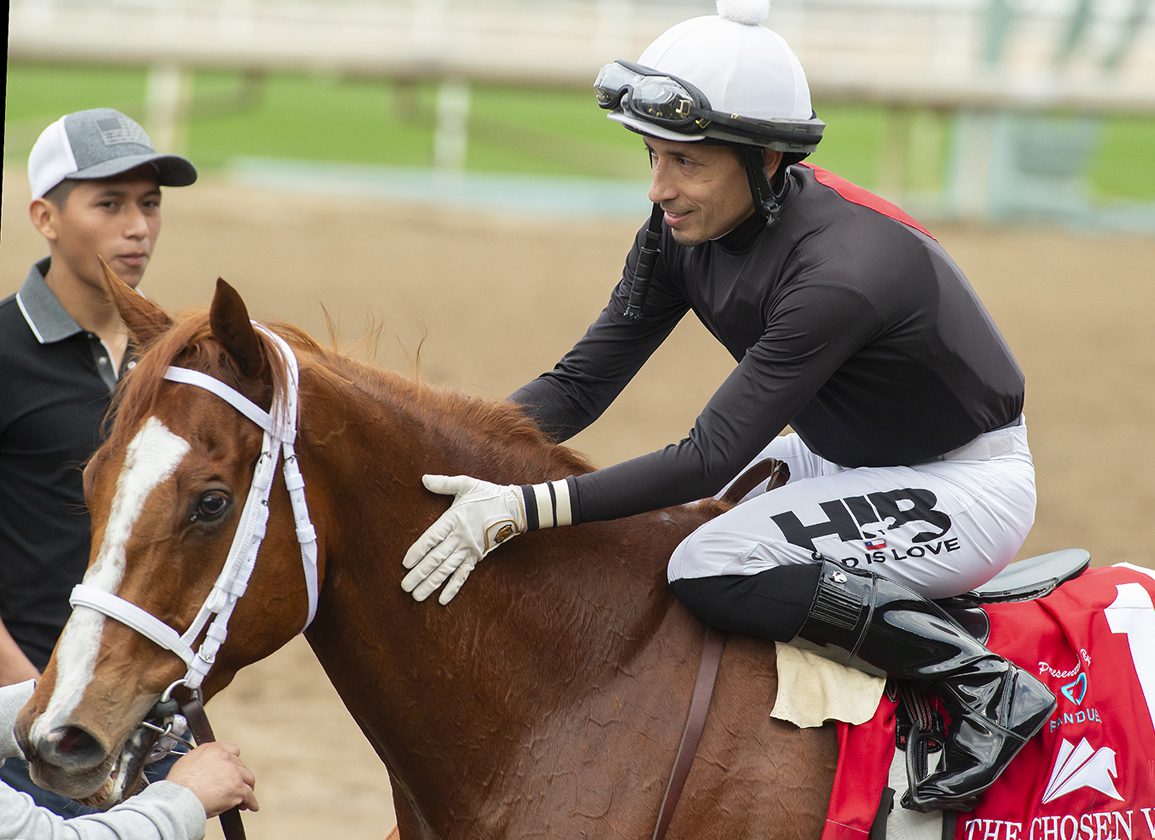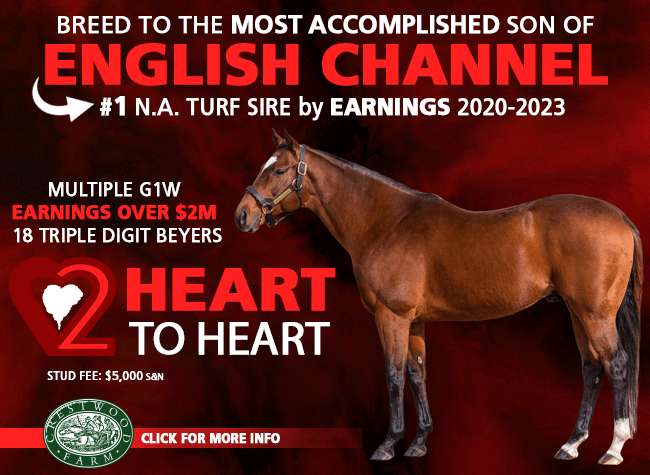By Chris McGrath
Last weekend represented a staging post on the Derby trail, a chance not only to reflect on some rather puzzling sophomore skirmishes, to this point, but also to celebrate fulfilments that remain far more pertinent to the vast majority of Thoroughbreds.
After all, very few get anywhere near testing their eligibility for the Classics and few others, certainly among the male of the species, will contrive a second career from such opportunities as remain once they have missed that one. That's why purses are so important. Otherwise racehorse ownership would depend entirely on an ancillary industry that annually divides access to a bare handful of colts and a contrasting surfeit of mares, many of them only marginally qualified.
First and foremost, all these horses are born–and bought–to run. Hats off, then, to a 6-year-old gelding whose popularity now extends far beyond the local theater he has long dominated. Following a 16th success in 21 starts, in the GIII San Carlos S., The Chosen Vron (Vronsky) has now banked a few cents short of $1.3 million. Trained by the former private detective Eric Kruljac, he's a great story, and surely making new fans on a circuit that has done a fabulous job in enabling our community to go back out and face Main Street with a clear conscience.
But perhaps this horse can also remind those who treat the racetrack as a means, rather than an end, that precocity is too often conflated by commercial breeders with elite speed. Sure, he romped on his juvenile debut (albeit on Dec. 27). But it's actually in maturity, as in his own Grade I breakout last summer, that speed validly signposts class.
Classic racing is itself considered instructive for breeders precisely because it requires the adolescent Thoroughbred to carry speed into tasks only within the compass of a strengthening physique. And, even round a single turn, we've just awarded yet another Horse of the Year trophy to one that was anything but precocious.
In that context, it's a shame that The Chosen Vron can't recycle his exceptional dash, character and soundness. True, he would never have introduced us to those qualities but for the discovery that a displaced testicle was interfering with his athleticism. But his late sire Vronsky, who died three years ago, deserved to leave a male heir.
That's not just because Vronsky had a proven ability to pass on wholesome genes: his 2018 crop, comprising no more than 43 live foals, includes not only The Chosen Vron but another indefatigable millionaire in four-time Grade II winner Closing Remarks; while his first Grade I winner, What a View, spread his eight-for-31 career across six campaigns. It's also because there's no mystery whatsoever where Vronsky found such prowess.
With only a modestly competent track career, featuring a maiden and a couple of allowance wins, he instead owed his chance at stud to pedigree and physique. Consigned by co-breeder Arthur Hancock of Stone Farm, he'd been a seven-figure Keeneland September yearling in 2000, his inherent appeal–as a son of Danzig out of multiple turf stakes scorer Words of War (Lord At War {Arg})–having been enhanced just days previously by the GI Del Mar Oaks success of his half-sister No Matter What (Nureyev). But his family tree would subsequently go into full bloom.
First the foal between No Matter What and Vronsky, a $1.35-million yearling by Mr. Prospector, as E Dubai ran second in the GI Travers S. and won the GII Suburban H. Then a full-sister to Words of War, the graded stakes winner Ascutney, became dam of GI Breeders' Cup Classic winner Raven's Pass, while No Matter What produced Rainbow View (Dynaformer) to become a dual Group 1 winner in Europe, besides three other graded/group winners.
On paper Vronsky didn't have much to work with in The Chosen Vron's dam, Tiz Molly (Tiz Wonderful). She had cost Kruljac $25,000 as a yearling and was retained at just $1,200 when offered at a breeding stock sale, despite having meanwhile won twice in a career cut short by injury. But she did have some blood behind her, her mother being half-sister to Canadian champion Delightful Mary (Limehouse) and GII Ohio Derby winner Delightful Kiss (Kissin Kris), as well as to the dam of Wilson Tesoro (Jpn) (Kitasan Black {Jpn}), a Group 1 runner-up in Japan last year.
We'll never know whether The Chosen Vron might have been an effective conduit for genes that have functioned so well on the track. But even his “page” won't ever be his sire's best–because that will always be found among those that make Count Vronsky's dramatic steeplechase scene, in Anna Karenina, one of the most famous in Russian literature.
Another Noble Family Denied an Outlet
In a horrible shock, last weekend also reduced a young stallion to a legacy only marginally beyond that available to the gelding whose more cheerful headlines we've just been celebrating. And the loss of Improbable felt all the more poignant because he, too, represented a family loaded with just the kind of genetic assets that the modern breed most requires.
For it can hardly be a coincidence that a page with Hard Spun front and center should have given us a horse whose juvenile Grade I success turned out only to be a downpayment for what he would achieve in maturity, when a hat-trick of elite scores qualified Improbable as champion older horse.
Hard Spun is half-brother to the second dam of Improbable, their mother Turkish Tryst (Turkoman) in turn being out of Darbyvail, a Roberto half-sister to champion Little Current (Sea-Bird {Fr}). Can't miss the Darby Dan flavors here and, sure enough, the next dam is the farm's matriarch Banquet Bell (Polynesian), who delivered two champions by Swaps in Primonetta and Chateaugay.
Primonetta proceeded to become a Broodmare of the Year, as dam of two Grade I winners and another pair at Grade II/Group 2 level. Yet her branch of the dynasty has faded, while Darbyvail's modest record both on the track and in the paddocks would instead be relieved by a daughter of Turkoman, of all horses. In much the same way, Hard Spun's brilliance found little reflection in his siblings. A filly by Stravinsky named Our Rite of Spring did win a stakes race, however, earning her early chances with top stallions including A.P. Indy. By the time the latter's daughter had produced Improbable, however, Our Rite of Spring had been sold for just $5,000 to finish her career in Colorado.
Obviously his damsire A.P. Indy can only have contributed usefully to Improbable, and likewise his own late sire, City Zip–whose prospects of salvaging the Carson City line now appear to be divided between the very promising Collected (three Grade II winners from his first sophomores last year, and now a leading GI Kentucky Oaks prospect in Lemon Muffin) and the three crops granted to poor Improbable.
His imminent first runners will represent a crop of 127 live foals; the next comprised 99; and presumably the last full one will be rather less. Overall that gives Improbable only a fleeting window of opportunity, and our hearts go out to the WinStar team, who first committed to the horse all the way back as a Keeneland September yearling.
Thankfully the royal Darby Dan genes that brand his family still have a priceless outlet through Danzig's parting gift, Hard Spun. Except he's not priceless, of course. At $35,000, Hard Spun remains among the very best value in Kentucky–where he now has four young sons (Silver State, Aloha West, Two Phil's and Spun to Run) competing to redress this weekend's tragic loss to a family that has condensed toughness as well as brilliance.
…And Another Hardy Perennial
On 15 April 2018, barely two weeks after The Chosen Vron was foaled in California, on the opposite coast a colt by Munnings slithered into the straw on a small Maryland farm. His mother, Listen Boy (After Market), had been stakes-placed in a fairly light career for her breeders at neighboring Sagamore, but was culled from that program for just $25,000 at the 2015 Keeneland November Sale. Earlier that year she had delivered her first foal, a son of First Defence (whose purchasers showed macabre humor–remember the mare is called Listen Boy–in naming him Nuclear Option) who would go on to prove a hardy 11-for-59 campaigner.
A couple of years later the mare's purchasers, Leonard and Patricia Pineau of Three Pines Farm, shrewdly sent her to Munnings who was then still building his reputation at $25,000. (The Ashford sire, albeit seemingly in perennial vogue, stands on the brink of fresh momentum with his forthcoming yearlings conceived at $85,000, more than double the previous crop.)
The resulting colt was sold at Keeneland September for $80,000, proving a solid pinhook for Grassroots Training & Sales at $140,000 at OBS the following April. Named Jaxon Traveler by purchasers West Point Thoroughbreds, he was precocious enough to be an unbeaten stakes winner at two, but his GIII Whitmore S. success confirms him to be better than ever in his fifth campaign. That makes him an apt winner of the race honoring an evergreen sprinter who, in his own career, similarly reminded us that Thoroughbreds tend not to approach their physical prime until long after the age when the best are often retired.
The big difference between Jaxon Traveler and Whitmore or The Chosen Vron, of course, is that he retains the equipment required for a second career. So perhaps he'll emulate his grandsire Speightstown as a late starter at stud somewhere.
For a dual Grade I winner by a sire of sires out of Tranquility Lake (Rahy), After Market was a disappointing stallion and ended up in Turkey. But his daughter has here been skilfully managed to produce some very sound stock by modern standards, an aspiration that has turned out to be very much our theme of the week.
Heard the Buzz?
The group of sires about to send a third crop of juveniles into the fray is proving a very competitive one, among others featuring Justify, Good Magic and Bolt d'Oro, plus several who appear to be seizing a much narrower chance. The busiest sires in the intake, studmates Mendelssohn and Justify, have so far had 262 and 216 starters, respectively, whereas Army Mule, Girvin and Oscar Performance have muscled into the top 10 (by cumulative earnings) with between 112 and 115 starters apiece.
But not even these can match the ratio of stakes winners quietly assembled by Bee Jersey, whose son Beeline became his sixth black-type scorer from just 48 starters in the Hutcheson S. last weekend.
Beeline is typical of the atypical program that bred him. His third dam is one of its foundation mares, a twice-raced daughter of Secretariat named Ball Chairman, whose foals included Canadian champion Perfect Soul (Ire) (Sadler's Wells). Their owner Chuck Fipke runs an extraordinary stable, largely comprising not only homebreds, but homebreds by homebred stallions. He sends valuable mares to sires that you or I can hire at bargain fees. And it keeps paying off.
Jersey Town admittedly arrived in utero, with his $700,000 dam, and went on to win the GI Cigar Mile. Retired to stud, Fipke sent him a mare whose fourth dam is matriarch Lassie Dear (Buckpasser), and the result was Bee Jersey, lightning-fast winner of the stallion-making GI Met Mile.
Bee Jersey's first sophomores last year included three runners-up in graded stakes, all naturally bred by Fipke. Perhaps Beeline, sold as a 2-year-old at OBS last June to Bradley Thoroughbreds for $70,000, can give his sire a breakout score at that level. It's plainly only a matter of time, and you can't say that of too many $5,000 covers.
Not a subscriber? Click here to sign up for the daily PDF or alerts.







